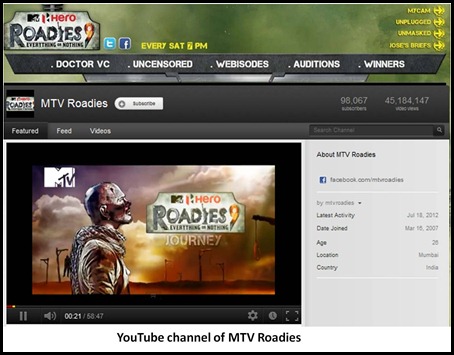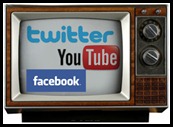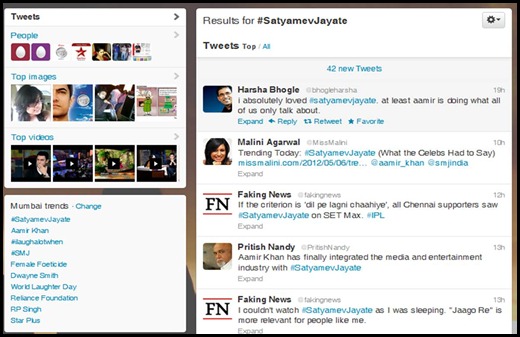Let’s admit it. Social media has radically changed the way content is consumed and enjoyed. Entertainment too, has fallen prey to its charms. Television being the biggest and the most prominent source of entertainment has undergone a sea-change when it comes to doling out programmable content. Leading the pack are the reality shows that have almost single handedly outweighed other scripted programs. And these reality shows provide an excellent opportunity for integrating social media to enhance viewers’ experience.
Viewer engagement gets a boost in the arm:
The ulterior purpose of getting onto the social media band wagon for any reality TV show is to get more viewers and creating better viewing experiences. For the most part this would mean how a show could engage fans and hold their interest in stead. Through various social platforms like Facebook, Twitter, Foursquare, YouTube etc. the reality shows could harvest some fame beyond the accepted limited shelf life of such series.
Setting up the command center:
Facebook, the biggest and the most ubiquitously popular social networking site of all could lay the foundation for any reality show and serve as their command centre. A dedicated page on the website could be the base during the pre-launch days to create buzz. The pre-launch buzz could be created by an announcement on the brand’s (channel’s reality show) page, followed by Facebook ads that appear across profiles. The initial profile of contestants and judges during this stage would let the audience choose their favourite and build u p anxiety and anticipation.
p anxiety and anticipation.
While it airs on the TV, this same page could be used to get the audience talking in real time and post the airing of an episode, the build up to the next episode could kick off here besides being aided by promotions on other parallel social platforms. Once the show has commenced, episode specific updates in real time could keep the audience connected to the show. In case the show is a competition of sorts, then at this stage the brand page could be used for polls and voting. Activities such as debates around contestant behavior could be initiated. One could even bring in innovative gaming and engaging content in sync with the theme to propel interactivity and increased stay on the page. In fact, by employing other real-time platforms further more engagement can be built upon (We’ll talk about it in a moment).
Post each episode or season, the highlights could be shared here and the fans could be encouraged to comment by sharing their opinions on the episode and their expectations from the next in the row.
Establishing visual reinforcement:
YouTube by its nature is engaging and has its features aligned to that of a reality television show which makes it more so a medium to be engaging the show’s audience. A dedicated channel with a customized background and video clips of various contestants, hosts and judges could keep the audience on the hook when they’re not actually watching the episode.
From previews and highlights to inside peaks  and behind the scenes of episodes to post episode/season reviews and guest speaks the show could have a lingering effect in the minds of its target audience. Integrating it with channels and sharing such videos will potentially lure in others and help expanding the viewer base.
and behind the scenes of episodes to post episode/season reviews and guest speaks the show could have a lingering effect in the minds of its target audience. Integrating it with channels and sharing such videos will potentially lure in others and help expanding the viewer base.
Readers would agree that gripping viral videos are stellar performers when it comes to creating awareness and increase viewership, as recent history bears testament to it. Similar viral video content based on the show’s theme, or even candid moments and bloopers, could prove to do wonders for the brand and what better place to start than the brand’s YouTube channel, a warehouse of all video content related to the show?
Lock, load and explode:
Twitter and Foursquare, again, in the geo-location and real time domain are the leading social networking sites. Considering the fact that the shelf life of a reality show is rather limited vis-à-vis a scripted TV program, with the show’s presence on a dedicated page on twitter or through integration with Foursquare, the brand could tap on the real time engagement during the show and get an estimated geo-targeted reach.
While twitter will keep the audience engaged in real time by making them a part and parcel of the show by gauging their response and cues, foursquare would enable the brand to know where there select audience check in from time to time. This could prove to be quite a handy research tool to determine the content the audience prefers by tapping on their psychographics and in the long run, to be treated as primary research for future projects.
An interesting concept, for use of such real time platform could be, audience round, where people on Twitter are asked to suggest next action or performance and then the participants of the reality show having to execute the same. This would probably be the highest form of engagement that the audience can have with their favourite shows.
The day after tomorrow:
The success of reality shows like the American Idol, So you think you can dance and closer home shows like MTV Roadies, Satyamev Jayate, Indian Idol, Big Boss etc. gives us a fair understanding how these shows are doing social media right.
For instance, Aamir Khan who made his debut on Indian Television with Satyamev Jayate, received a phenomenal response from both fans and critics and the social media literally exploded. Right after the first episode, the show’s website received 42, 000 likes on Facebook. To capitalize on the buzz, the debut episode was made available on the website for viewing right after the telecast. The episodes were in due course uploaded on the channel’s YouTube page for those who might have missed out on the live telecast.
In fact, the synergy of reality TV shows and social media is turning out to be such a crowd puller that it has been recently announced that the producers of American Idol, will release their latest reality TV series on Facebook in a move that would truly be historic. A Chance to Dance is slated to be the first TV show to air on the social network and cable channel at the same time. According to Dean Alms, VP of marketing at Milyoni, that is building the social entertainment software on Facebook, “Reality TV can take advantage of the concentrated activity on social networks to build buzz around the show week to week.”
Are these signs of changing times in an age where reality TV shows are trying to grab a bigger portion of the (audience) pie? You decide. Let us know what you think of the integration of social media with reality shows as a measure to create that difference.


